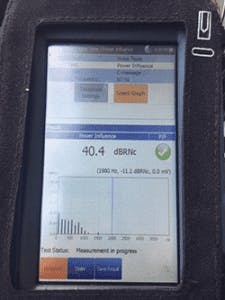My colleague Russ Gundrum and I helped Sam, a fiercely dedicated manager, solve a problem that several technicians were unable to resolve — and they gave up.
The customer had so much noise on her line that she was unable to hear or talk; without a cell phone, she was left without a connection to the outside world. When the problem was resolved, she actually cried. Neither Russ nor I collected a dime and yet we agreed this was the best compensation we’ve received in our decades of solving trouble cases. We were honored to meet this manager who was dedicated to delivering a great customer experience.
The Challenge
The unbearable noise on this customer’s line could have been resolved quickly if the power company and telco had teams identified who would collaborate across boundaries. I’ve rarely seen this happen; however, that doesn’t mean you can’t help the customer. There are solutions and steps you can take to find a path to success when you have noise caused by power influence (PI).
InvisiLight® Solution for Deploying Fiber
April 2, 2022Go to Market Faster. Speed up Network Deployment
April 2, 2022Episode 10: Fiber Optic Closure Specs Explained…
April 1, 2022Food for Thought from Our 2022 ICT Visionaries
April 1, 2022The Process
On May 8, I forwarded an email to Russ from Sam, an OSP Manager, who explained some things about a customer’s line, such as the total loop length was 35,973 feet. The PI was almost at 90 dBrnC, and this was with a 12-pair induction neutralizing transformer (INT) installed. It had been over 100 dBrnC before the INT was placed. But even with well-balanced pairs, you would still have an unacceptable level of circuit noise.
Russ talked to Sam the next day, and said it sounded like they didn’t have a good exciter pair for the INT, as it should be dropping much more of the PI. Plus, it might not be at the right location to cause the best noise reduction.
Russ also suggested that a voltage-to-ground measurement should be made on the pair on both sides of the INT, and then read the voltage drop across the INT on that pair. If the INT is properly excited, you should read approximately the sum of those 2 voltages. If you don’t, then the INT isn’t working properly. You should make sure the exciter pair goes to a good ground at both ends of the circuit, and that there are no grounds on any other pairs close to the INT, as this will affect its performance.
Russ also pointed out the fact that since the significant frequency levels of the PI were at the higher end of the voice band, 3 or more exciter pairs might be needed to get enough excitation current through the INT to do its job. Turns out that wouldn’t be a problem to do, since she was the only one working circuit in the cable!
After trying more exciter pairs and moving the INT towards the node, the PI was reduced to 80 dBrnC, and the noise was also reduced 20 dB. However, since the induced voltage was only around 10 Vg, Russ suggested they also try a SNIX at the customer’s end to see if they might provide further improvement.
Well, on May 21, Sam sent us the following email: "After roughly 2 years of trouble shooting, or wasting time, we have a solution…. The SNIX and INT have officially fixed our problem. Y’all even made the lady cry a little bit with joy over how clear her dial tone is now! We can’t thank y’all enough and all the efforts. I’ll recommend y’all to every telco person I know. See the attached photos of the results. Thank you again very much."
SNIX placed at customer’s NID.
Test set showing only 40.4 dBrnc of PI.
Like this Article?
Subscribe to ISE magazine and start receiving your FREE monthly copy today!
Signing off
Russ, thank you for the privilege of working with you and this manager. It’s an honor to work with people who care so much and won’t give up. To all of you reading this column: please let us know about your toughest cases. We won’t use your name or your company’s name.We want to help brainstorm creative solutions that help you be successful. Contact me: [email protected] or text or call me at 831.818.3930 or Russ Gundrum.












